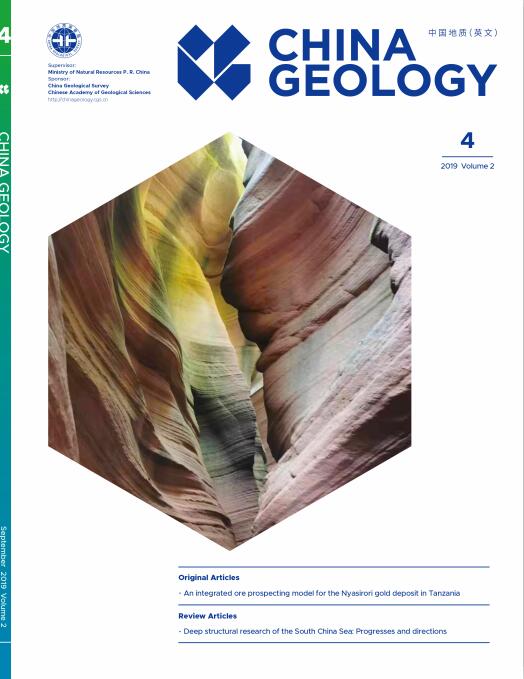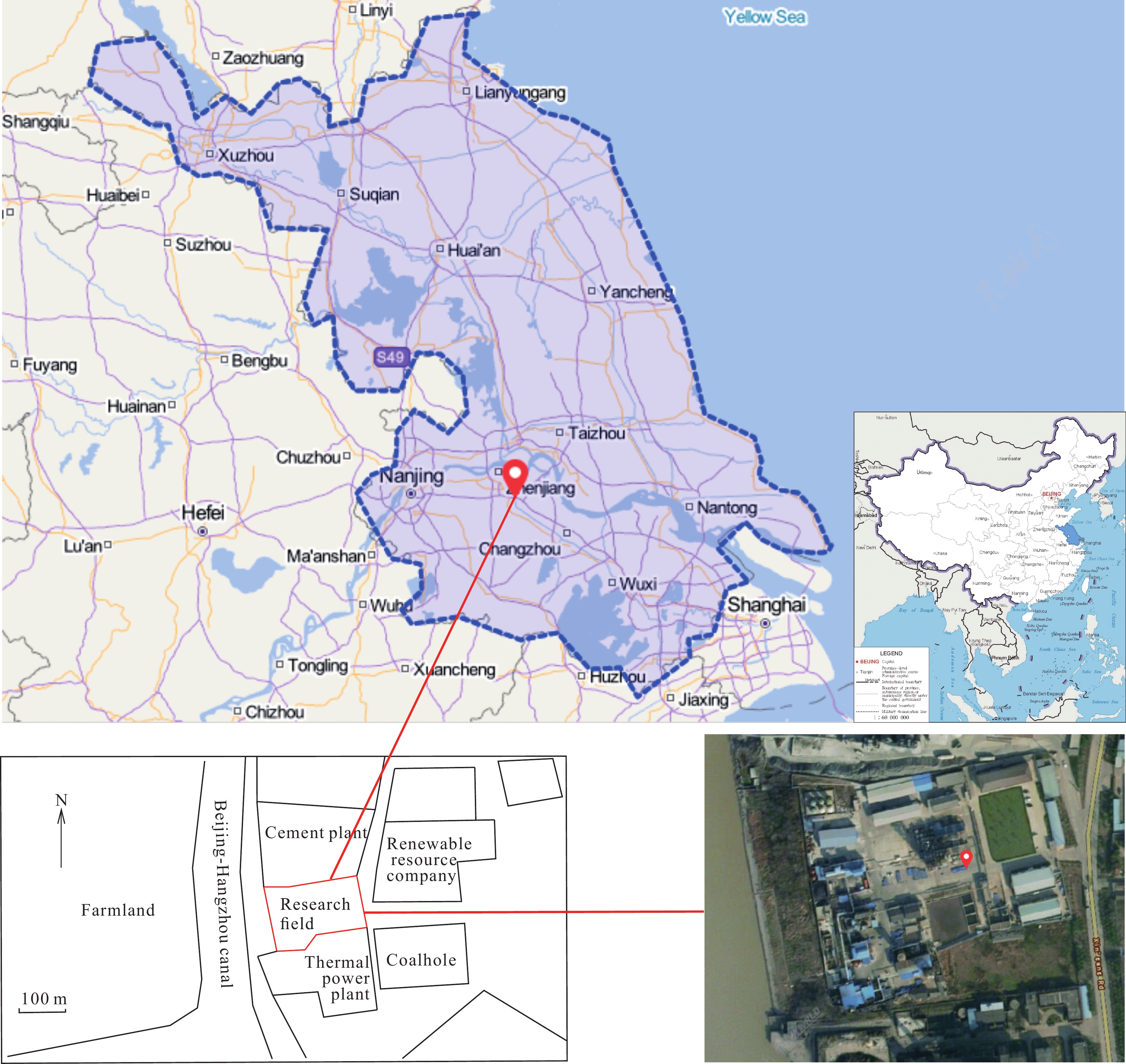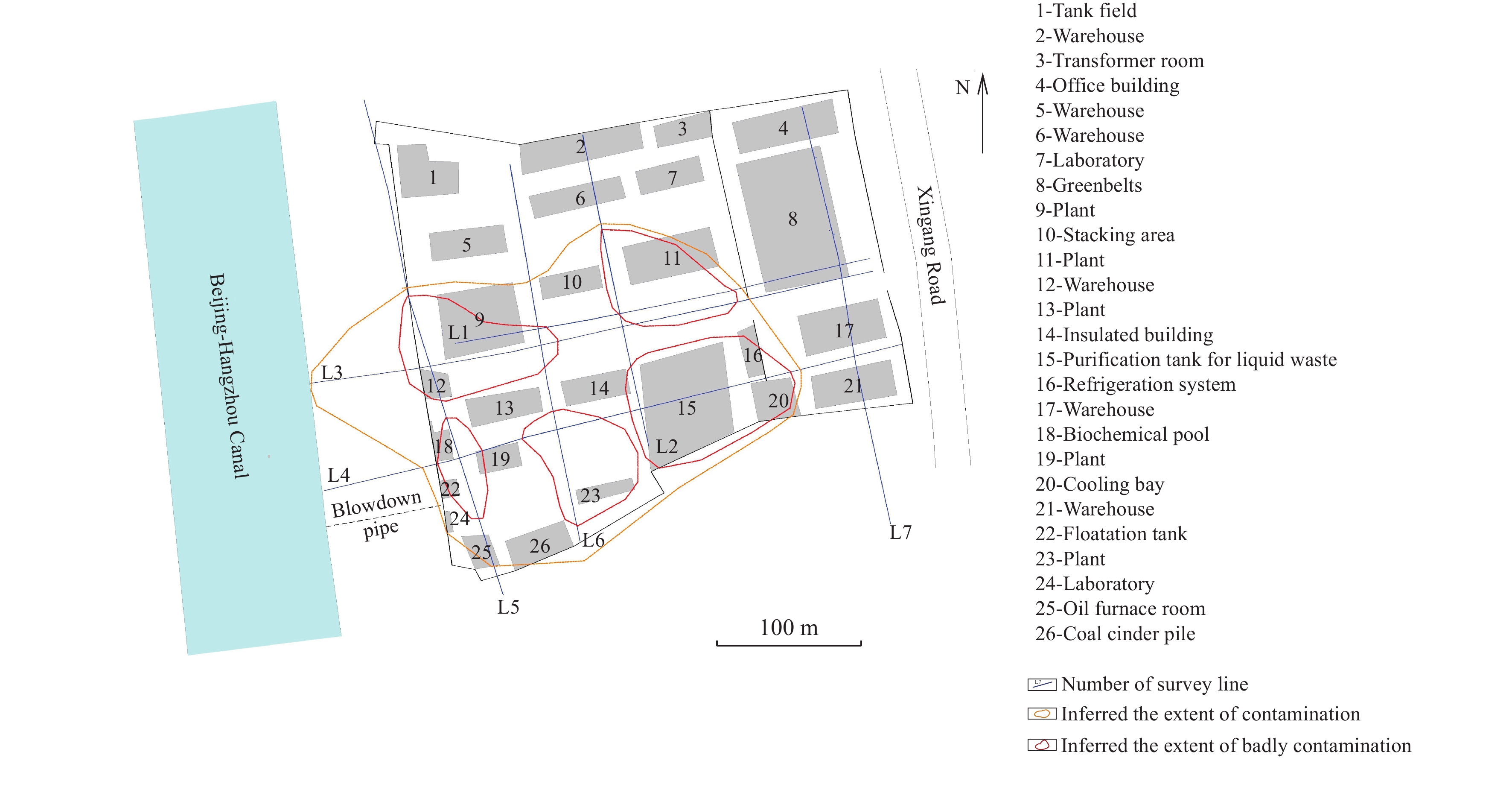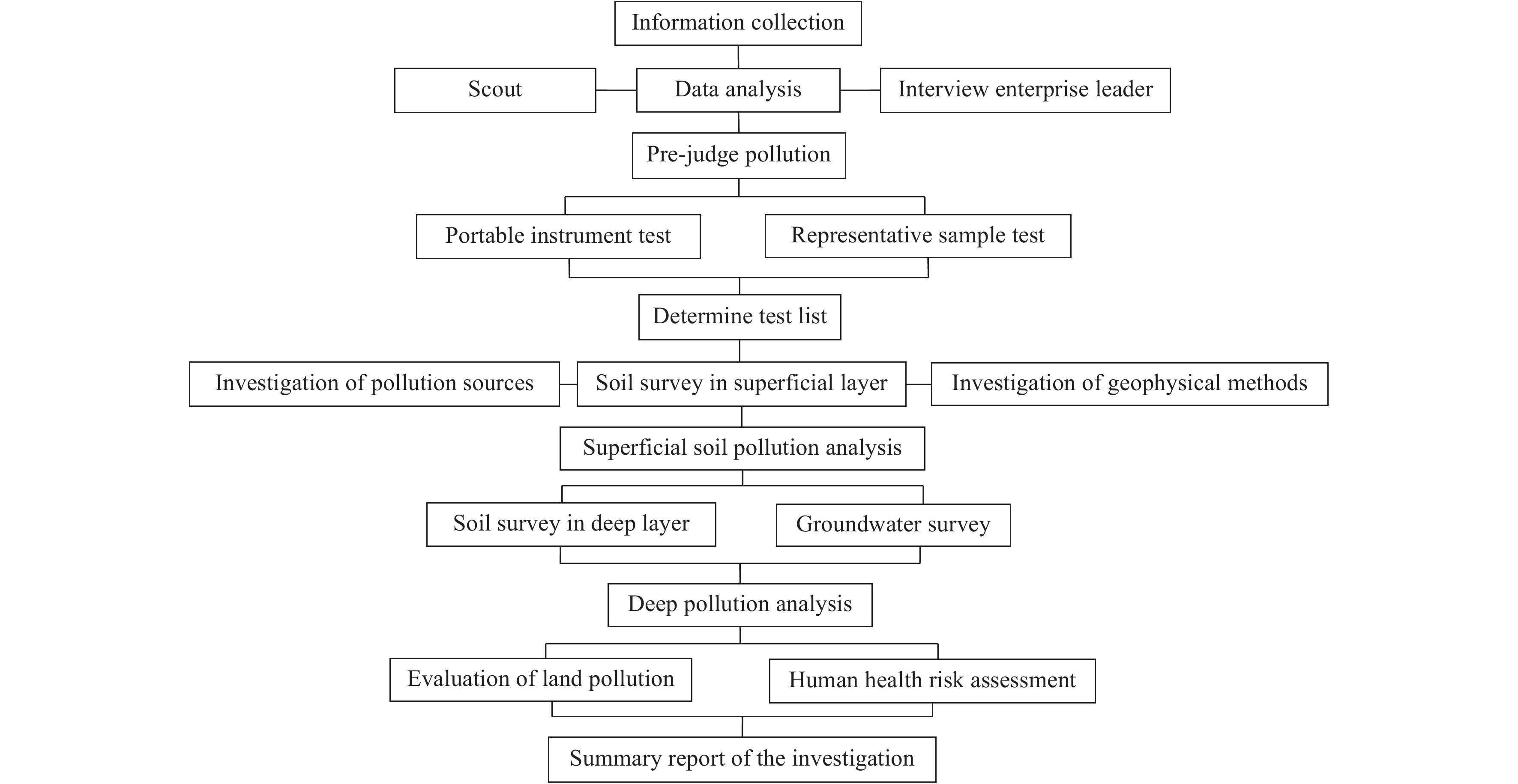| Citation: | Shuai Yang, Wei-ya Ge, Hong-han Chen, Wen-li Xu, 2019. Investigation of soil and groundwater environment in urban area during post-industrial era: A case study of brownfield in Zhenjiang, Jiangsu Province, China, China Geology, 2, 501-511. doi: 10.31035/cg2018128 |
Investigation of soil and groundwater environment in urban area during post-industrial era: A case study of brownfield in Zhenjiang, Jiangsu Province, China
-
Abstract
With the adjustment of industrial structure, many high pollution enterprises will gradually shut down. This process will produce a large number of high-risk pollution plots and cause a series of environmental problems. In this study, geophysical detection and direct push technology were applied to investigate soil and groundwater pollution in a typical brownfield in Zhenjiang, Jiangsu province, China. The results showed that Chlorotoluene and its ramification were the main pollutants for the brownfield. Pollution decreased with depth and was quite uneven in the brownfield. Production and wastewater treatment areas were heavily polluted, where volatile organic compounds contaminated and semi-volatile organic compounds were found 12 m and 15 m below the land surface, respectively. About 18880 m3 groundwater was contaminated. This study is significant to develop a geological survey work mode for the post-industrial era.
-

-
References
[1] Abdullahi S, Pradhan B. 2016. Sustainable brownfields land use change modeling using GIS-based weights-of-evidence approach. Applied Spatial Analysis and Policy, 9(1), 21–38. doi: 10.1007/s12061-015-9139-1 [2] Agostini P, Pizzol L, Critto A, D'Alessandro M, Zabeo A, Marcomini A. 2012. Regional risk assessment for contaminated sites Part 3: Spatial decision support system. Environment International, 48, 121–132. doi: 10.1016/j.envint.2012.07.005 [3] Alberti L, Lombi S, Zanini A. 2011. Identifying sources of chlorinated aliphatic hydrocarbons in a residential area in Italy using the integral pumping test method. Hydrogeology Journal, 19(6), 1253–1267. doi: 10.1007/s10040-011-0742-1 [4] Broholm MM, Janniche GS, Mosthaf K, Fjordboge AS, Binning PJ, Christensen AG, Grosen B, Jorgensen TH, Keller C, Wealthall G, Kerrn-Jespersen H. 2016. Characterization of chlorinated solvent contamination in limestone using innovative FLUTe (R) technologies in combination with other methods in a line of evidence approach. Journal of Contaminant Hydrology, 189, 68–85. doi: 10.1016/j.jconhyd.2016.03.007 [5] Charnley S, Engelbert B. 2005. Evaluating public participation in environmental decision-making: EPA’s superfund community involvement program. Journal of Environmental Management, 77(3), 165–182. doi: 10.1016/j.jenvman.2005.04.002 [6] Critto A, Cantarella L, Carlon C, Giove S, Petruzzelli G, Marcomini A. 2006. Decision support-oriented selection of remediation technologies to rehabilitate contaminated sites. Integrated Environmental Assessment and Management, 2(3), 273–285. [7] Cui Z, Yang P, Zhang Z. 2016. Comprehensive suitability evaluation of urban geological environment in Zhengzhou-Kaifeng area. Journal of Groundwater Science and Engineering, 4(03), 204–212. [8] Dixon T, Otsuka N, Abe H. 2011. Critical success factors in urban brownfield regeneration: an analysis of ‘hardcore’ sites in Manchester and Osaka during the economic recession (2009-10). Environment and Planning A, 43(4), 961–980. doi: 10.1068/a43468 [9] Dunea D, Iordache S, Pohoata A, Frasin LBN. 2014. Investigation and selection of remediation technologies for petroleum-contaminated soils using a decision support system. Water Air and Soil Pollution, 225(7), . [10] Guo GL, Wang X, Guan L, Yan ZG, Gu QB, Li FS. 2009. Site-specific spatial distribution of VOC/SVOC and determination of the remediation boundary. Acta Scientiae Circumstantiae, 29(12), 2597–2605 (in Chinese with English abstract). [11] Kao NH, Su MC, Fan JR, Chung YY. 2015. Identification and quantification of biomarkers and polycyclic aromatic hydrocarbons (PAHs) in an aged mixed contaminated site: From source to soil. Environmental Science and Pollution Research, 22(10), 7529–7546. doi: 10.1007/s11356-015-4237-9 [12] Kim D, Lu JC, Park JS. 2015. Comprehensive environmental investigation at former industrial/petroleum underground storage tank sites in Long Beach, CA: A forensic perspective. Environmental Forensics, 16(1), 27–41. doi: 10.1080/15275922.2014.991007 [13] Komnitsas K, Modis K, Doula M, Kavvadias V, Sideri D, Zaharaki D. 2016. Geostatistical estimation of risk for soil and water in the vicinity of olive mill wastewater disposal sites. Desalination and Water Treatment, 57(7), 2982–2995. doi: 10.1080/19443994.2014.983988 [14] Liao XY, Chong ZY, Yan XL, Zhao D. 2011. Urban industrial contaminated sites: A new issue in the field of environmental remediation in China. Chinese Journal of Environmental Science, 32(3), 784–794 (in Chinese with English abstract). [15] Liu CY, Sun JC, Jing JH, Zhang Y, Guo WX. 2016. Distribution characteristics and source of BTEX in groundwater in Guangzhou, Guangdong Province, P. R. China. Journal of Groundwater Science and Engineering, 4(03), 238–246. [16] Liu F, Wang SM, Chen HH. 2010. Progress of investigation and evaluation on groundwater organic contaminants in western countries. Geological Bulletin of China, 29(6), 907–917 (in Chinese with English abstract). [17] Liu XS, Cai WT, Li ST. 2010. Survey of soil and groundwater contamination in oil pollution site. Hydrogeology & Engineering Geology, 37(4), 121–125 (in Chinese with English abstract). [18] Liu YM, Li YC, Xiao RB. 2013. Management experience of industrial contaminated sites in western countries and its implications for China. Ecology and Environmental Sciences, 22(8), 1438–1443 (in Chinese with English abstract). [19] Luo F, Song J, Pan YY, Wei J, Huang YJ, Wu CF, Luo YM. 2012. Human health risk assessment of contaminated soil: A case study of a former DDT manufacturing site. Acta Pedologica Sinica, 49(1), 26–35 (in Chinese with English abstract). [20] Luo YM. 2009. Trends in soil environmental pollution and the prevention-controlling-remediation strategies in China. Environmental Pollution and Control, 31(12), 27–31 (in Chinese with English abstract). [21] Lv XL, Shao JL, Liu JT, Huang GX, Zhang Y, Cui HW, Wen JL, Liu JJ, Sun JC. 2012. Contamination characteristics and causes of volatile organic compounds in the groundwater at a petrochemical contaminated site. Hydrogeology and Engineering Geology, 39(6), 97–102 (in Chinese with English abstract). [22] Naidu R, Nandy S, Megharaj M, Kumar RP, Chadalavada S, Chen ZL, Bowman M. 2012. Monitored natural attenuation of a long-term petroleum hydrocarbon contaminated sites: A case study. Biodegradation, 23(6), 881–895. doi: 10.1007/s10532-012-9580-7 [23] Paul S, Rutter A, Zeeb BA. 2015. Phytoextraction of DDT-contaminated soil at point Pelee national park, Leamington, ON, Using Cucurbita pepo Cultivar Howden and native grass species. Journal of Environmental Quality, 44(4), 1201–1209. doi: 10.2134/jeq2014.11.0465 [24] Ramalho EC, Khalil MA, Fernandes J, Amaral H, Santos FM. 2015. Geophysical assessment of contamination due to explosives in an abandoned facility towards its hydrogeological characterization. Environmental Earth Sciences, 74(1), 649–663. doi: 10.1007/s12665-015-4070-y [25] Rijal ML, Porsch K, Appel E, Kappler A. 2012. Magnetic signature of hydrocarbon-contaminated soils and sediments at the former oil field Hanigsen, Germany. Studia Geophysica et Geodaetica, 56(3), 889–908. doi: 10.1007/s11200-010-0040-8 [26] Rivett MO, Dearden RA, Wealthall GP. 2014. Architecture, persistence and dissolution of a 20 to 45 year old trichloroethene DNAPL source zone. Journal of Contaminant Hydrology, 170, 95–115. doi: 10.1016/j.jconhyd.2014.09.008 [27] Schaedler S, Morio M, Bartke S, Rohr-Zaenker R, Finkel M. 2011. Designing sustainable and economically attractive brownfield revitalization options using an integrated assessment model. Journal of Environmental Management, 92(3), 827–837. doi: 10.1016/j.jenvman.2010.10.026 [28] Stewart RN, Purucker ST. 2011. An environmental decision support system for spatial assessment and selective remediation. Environmental Modelling & Software, 26(6), 751–760. [29] Sun B and Yu DL. 2018. Study on Jinan urban construction planning based on the protection of karst landscape. Journal of Groundwater Science and Engineering, 6(04), 280–292. [30] Wang XH, Wei JH, Cheng ZN, Liu PB, Ji YQ, Zhang G. 2013. Groundwater organic pollution source identification technology system research and application. Chinese Journal of Environmental Science, 34(2), 662–667 (in Chinese with English abstract). [31] Xin J, Liu X. 2011. Review on the investigation and remediation methods of DDT-contaminated sites. Journal of Safety and Environment, 11(2), 28–34 (in Chinese with English abstract). [32] Zhong MS, Jiang L, Zhang LN, Xia TX, Han D, Yao JJ, Zheng D. 2015. Screening and evaluation of risk management strategies for a site contaminated by VOCs. Research of Environmental Sciences, 28(4), 596–604 (in Chinese with English abstract). [33] Zhu L. 2015. Membrane interface probe and its use in contaminated site investigation. The Administration and Technique of Environmental Monitoring, 27(1), 27–31 (in Chinese with English abstract). -
Access History

-
Figure 1.
Geographical location of the study area (Geographical maps come from the MAP WORLD).
-
Figure 2.
Map of sampling sites (a) superficial soils (b) deep soils.
-
Figure 3.
Spatial distribution of TVOC in shallow soils and vertical distribution of TVOC in soil samples at Z2, Z6, Z7, Z9.
-
Figure 4.
Results of the geophysical detection.
-
Figure 5.
Flow chart of soil and groundwater pollution investigation and risk assessment.





 DownLoad:
DownLoad:



